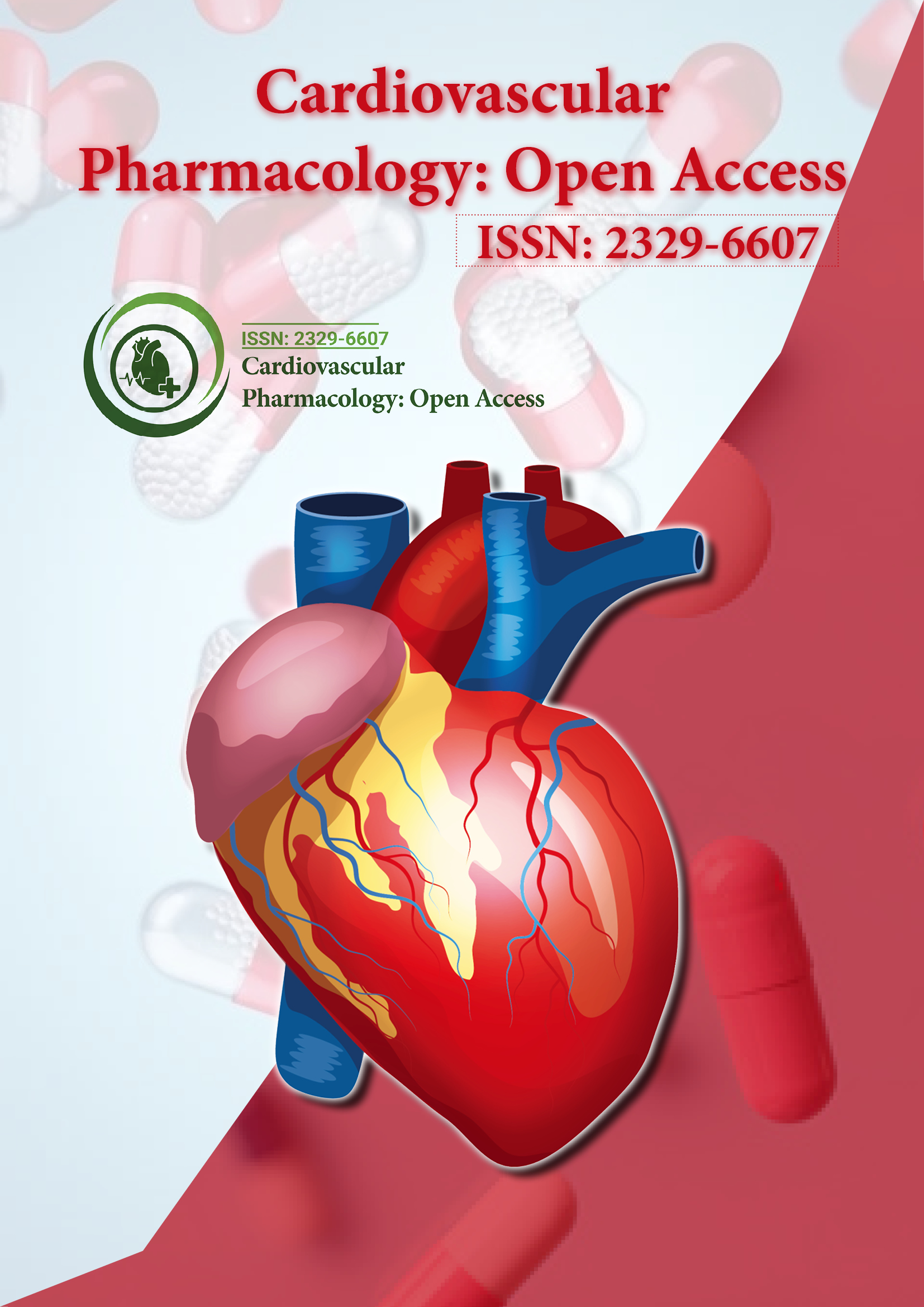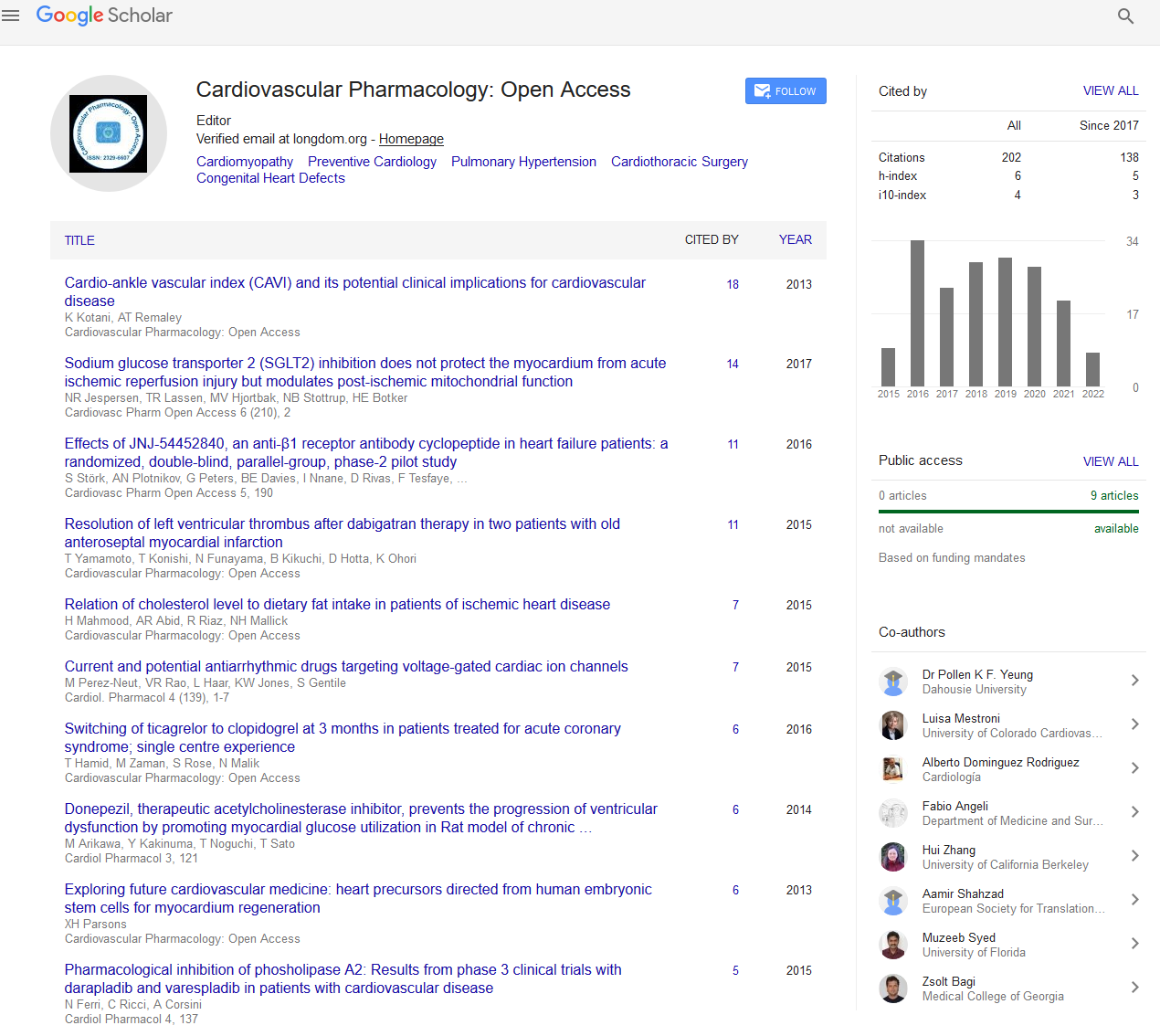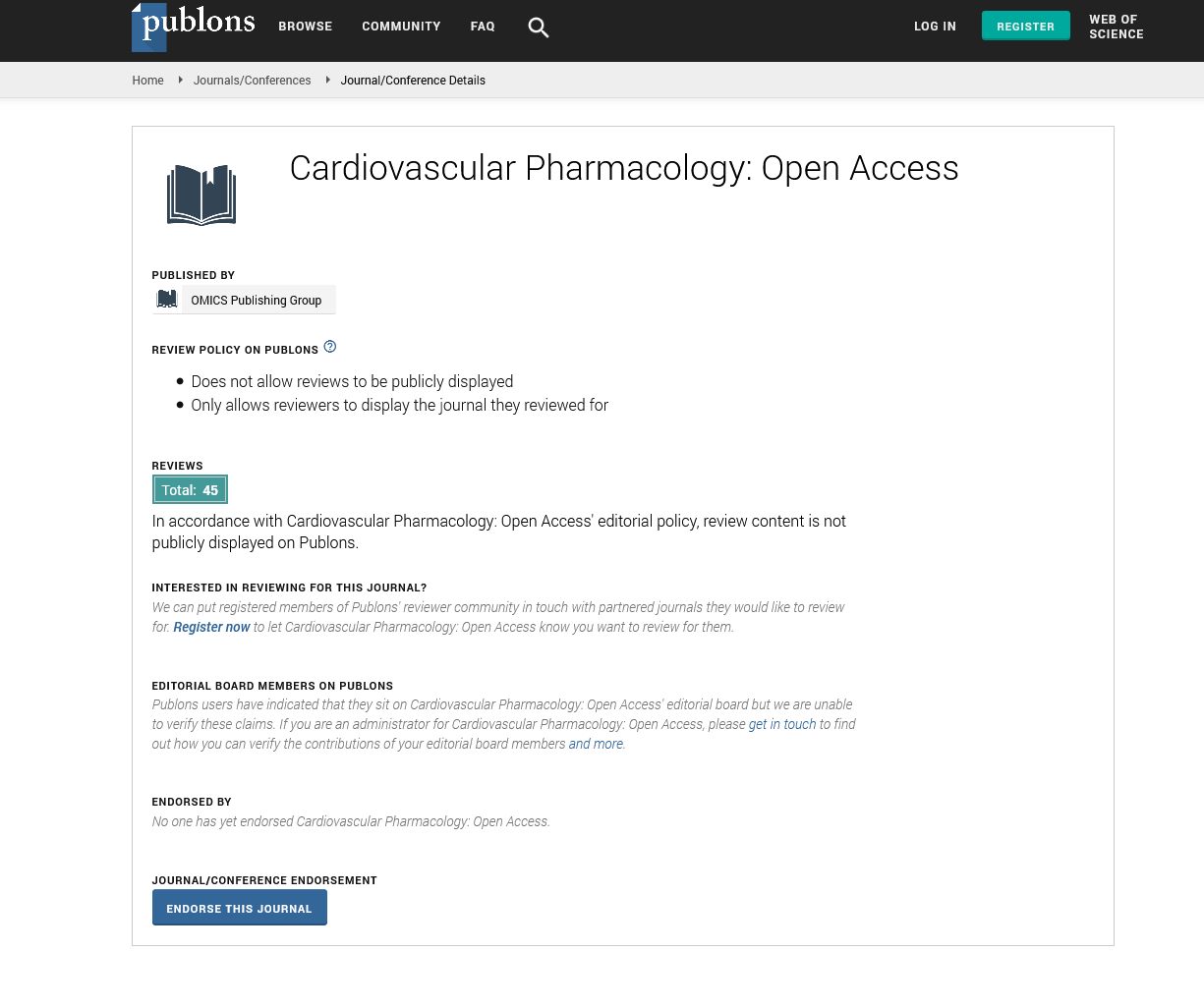Indexed In
- Open J Gate
- Cosmos IF
- RefSeek
- Hamdard University
- EBSCO A-Z
- OCLC- WorldCat
- Publons
- Geneva Foundation for Medical Education and Research
- Euro Pub
- Google Scholar
Useful Links
Share This Page
Journal Flyer

Open Access Journals
- Agri and Aquaculture
- Biochemistry
- Bioinformatics & Systems Biology
- Business & Management
- Chemistry
- Clinical Sciences
- Engineering
- Food & Nutrition
- General Science
- Genetics & Molecular Biology
- Immunology & Microbiology
- Medical Sciences
- Neuroscience & Psychology
- Nursing & Health Care
- Pharmaceutical Sciences
Short Communication - (2024) Volume 13, Issue 2
Pharmacological Modulation of Inflammation in Cardiovascular Disease: Advances and Challenges
Litian Feng*Received: 24-May-2024, Manuscript No. CPO-24-27319; Editor assigned: 27-May-2024, Pre QC No. CPO-24-27319 (PQ); Reviewed: 10-Jun-2024, QC No. CPO-24-27319; Revised: 18-Jun-2024, Manuscript No. CPO-24-27319 (R); Published: 26-Jun-2024, DOI: 10.35248/2329-6607.24.13.399
Description
Inflammation plays a pivotal role in the initiation, progression and complications of Cardiovascular Disease (CVD). It has become clear that beyond traditional risk factors like hyperlipidemia and hypertension, chronic inflammation significantly contributes to atherosclerosis, myocardial infarction and heart failure. Thus, pharmacological approaches targeting inflammation have achieved attention as potential therapies for reducing cardiovascular risk and improving outcomes. Although several advances have been made in understanding and modulating inflammatory pathways, challenges remain in translating these therapies to clinical practice due to issues related to safety, efficacy and precision targeting.
Understanding inflammation in cardiovascular disease
The inflammatory process in CVD is complex, involving a host of cellular and molecular mechanisms. At its core, inflammation is the body’s response to injury, infection, or stress. In the context of CVD, it is often a response to endothelial damage caused by risk factors such as high LDL cholesterol, smoking and hypertension [1]. This damage leads to the recruitment of immune cells like monocytes and T-cells, which infiltrate the arterial wall, increasing the atherosclerotic process.
Advances in anti-inflammatory pharmacotherapies
Several classes of drugs have shown potential in modulating inflammation for CVD prevention and treatment. These include targeted cytokine inhibitors, colchicine and emerging lipid- lowering agents with anti-inflammatory effects.
Cytokine inhibitors: One of the most notable advances in anti-inflammatory therapy for CVD has been the use of cytokine inhibitors. The Canakinumab Anti-inflammatory Thrombosis Outcomes Study (CANTOS) trial was a landmark study demonstrating that blocking IL-1β with canakinumab, a monoclonal antibody, reduced major cardiovascular events in patients with a history of myocardial infarction and high CRP levels [2,3]. The trial provided direct evidence that targeting inflammation can yield cardiovascular benefits independently of lipid levels. However, canakinumab was associated with a higher risk of infections, underscoring the challenge of maintaining safety in immunomodulatory therapies.
Colchicine: Colchicine, an anti-inflammatory drug traditionally used to treat gout, has shown efficacy in reducing cardiovascular events, particularly in patients with stable coronary artery disease and recent myocardial infarction [4]. The COLCOT and LoDoCo2 trials demonstrated that low-dose colchicine reduced the incidence of cardiovascular events, likely through its ability to inhibit microtubule assembly in leukocytes, thereby reducing neutrophil activation and inflammatory cytokine release. Colchicine’s relatively low cost and manageable safety profile make it an attractive option for long-term anti-inflammatory therapy in CVD.
Lipid-lowering agents with anti-inflammatory effects
Statins, primarily used for their lipid-lowering properties, have anti-inflammatory effects by reducing CRP levels and modulating endothelial function. However, their anti- inflammatory effects are often indirect, mediated by lowering LDL cholesterol [5]. Emerging lipid-lowering agents, like PCSK9 inhibitors (e.g., alirocumab, evolocumab), have shown CRP- lowering effects, though more evidence is needed to determine if these effects independently reduce inflammation in CVD.
Another potential agent is icosapent ethyl, a purified form of the omega-3 fatty acid Eicosapentaenoic Acid (EPA). In the REDUCE-IT trial, icosapent ethyl significantly reduced major adverse cardiovascular events in high-risk patients on statin therapy, potentially through anti-inflammatory effects. EPA derivatives have been shown to reduce CRP and inhibit inflammatory cytokine production, though the precise mechanisms remain under investigation.
Challenges in anti-inflammatory therapy for cardiovascular disease
While these pharmacotherapies offer hope for managing inflammation in CVD, significant challenges remain.
Balancing efficacy and safety: Modulating inflammation carries inherent risks, as the immune system is necessary for defending against infections and other threats. Drugs like canakinumab have demonstrated efficacy but have been associated with increased risk of infection. Finding a balance between effective inflammation reduction and immune suppression is critical to prevent adverse outcomes [6]. Therapies that selectively target cardiovascular inflammation without compromising systemic immunity are needed.
Identifying the right patients: Inflammatory biomarkers, such as CRP, are used to identify patients who may benefit from anti- inflammatory therapies. However, CRP is a non-specific marker and may not adequately capture the complex inflammatory region in all CVD patients. Precision medicine approaches, such as genetic profiling and advanced biomarker identification, are needed to determine which patients are most likely to benefit from anti-inflammatory therapies, potentially reducing overtreatment and associated risks.
Long-term impact and cost-effectiveness: The cost-effectiveness of anti-inflammatory therapies, especially biologics like canakinumab, remains a concern. Such therapies can be prohibitively expensive, raising questions about their affordability and accessibility for widespread use [7,8]. Additionally, long-term studies are needed to assess whether the cardiovascular benefits of anti-inflammatory therapies translate into prolonged survival and improved quality of life.
Understanding mechanisms of action and side effects: The mechanisms of action for many anti-inflammatory drugs in CVD are not fully understood, complicating their clinical use and dosing strategies. Additionally, side effects, such as gastrointestinal symptoms with colchicine or increased infection risk with cytokine inhibitors, highlight the importance of understanding off-target effects. Further mechanistic research could improve dosing regimens and identify patient populations that are less prone to adverse effects.
Future directions in anti-inflammatory cardiovascular therapy: The field of inflammation modulation in CVD is evolving rapidly, with potential research on new pathways and molecules. Targets such as the NLRP3 inflammasome, which regulates inflammatory responses in macrophages, are gaining attention for their role in atherosclerosis [9,10]. Drugs targeting the NLRP3 inflammasome could offer more specific anti- inflammatory effects without compromising broader immune functions.
Nanotechnology and drug delivery advancements are also opening doors to more precise and localized delivery of anti- inflammatory agents, potentially reducing systemic side effects. For instance, nanoparticle-based delivery systems could allow targeted drug release in atherosclerotic plaques, minimizing off- target effects.
Conclusion
Pharmacological modulation of inflammation represents an exciting frontier in cardiovascular disease management, with significant potential to reduce cardiovascular events and improve outcomes. While notable advances have been made with cytokine inhibitors, colchicine and lipid-modulating agents, challenges remain in achieving targeted, safe and effective therapies. Future research focused on precision medicine, innovative delivery systems and novel anti-inflammatory targets will be necessary to fully realize the benefits of anti- inflammatory pharmacotherapy in CVD.
References
- Awan Z, Genest J. Inflammation modulation and cardiovascular disease prevention. Eur J Prev Cardiol. 2015;22(6):719-733.
[Crossref] [Google Scholar] [PubMed]
- Schiano C, Vietri MT, Grimaldi V, Picascia A, De Pascale MR, Napoli C. Epigenetic-related therapeutic challenges in cardiovascular disease. Trends Pharmacol Sci. 2015;36(4):226-235.
[Crossref] [Google Scholar] [PubMed]
- Afzal M. Recent updates on novel therapeutic targets of cardiovascular diseases. Mol Cell Biochem. 2021;476(1):145-155.
[Crossref] [Google Scholar] [PubMed]
- Gómez‐Guerrero C, Mallavia B, Egido J. Targeting inflammation in cardiovascular diseases. still a neglected field?. Cardiovasc Ther. 2012;30(4):e189-e197.
[Crossref] [Google Scholar] [PubMed]
- Ridker PM, Lüscher TF. Anti-inflammatory therapies for cardiovascular disease. Eur Heart J. 2014;35(27):1782-1791.
[Crossref] [Google Scholar] [PubMed]
- K. Jain A, K. Mehra N, K. Swarnakar N. Role of antioxidants for the treatment of cardiovascular diseases: Challenges and opportunities. Curr Pharm Des. 2015;21(30):4441-4455.
[Crossref] [Google Scholar] [PubMed]
- Mohamed NA, Marei I, Crovella S, Abou-Saleh H. Recent developments in nanomaterials-based drug delivery and upgrading treatment of cardiovascular diseases. Int J Mol Sci. 2022;23(3):1404.
[Crossref] [Google Scholar] [PubMed]
- Landmesser U, Poller W, Tsimikas S, Most P, Paneni F, Lüscher TF. From traditional pharmacological towards nucleic acid-based therapies for cardiovascular diseases. Eur Heart J. 2020;41(40):3884-3899.
[Crossref] [Google Scholar] [PubMed]
- Steven S, Frenis K, Oelze M, Kalinovic S, Kuntic M, Bayo Jimenez MT, et al. Vascular inflammation and oxidative stress: major triggers for cardiovascular disease. Oxid Med Cell Longev. 2019;2019(1):7092151.
[Crossref] [Google Scholar] [PubMed]
- Papaconstantinou J. The role of signaling pathways of inflammation and oxidative stress in development of senescence and aging phenotypes in cardiovascular disease. Cells. 2019;8(11):1383.
[Crossref] [Google Scholar] [PubMed]
Citation: Feng L (2024). Pharmacological Modulation of Inflammation in Cardiovascular Disease: Advances and Challenges. Cardiovasc Pharm. 13:399.
Copyright: © 2024 Feng L. This is an open-access article distributed under the terms of the Creative Commons Attribution License, which permits unrestricted use, distribution and reproduction in any medium, provided the original author and source are credited.


